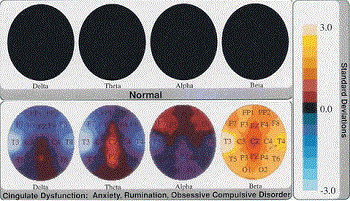A successful and alternative treatment for OCD
Here at the Scottsdale Neurofeedback Institute in Arizona we have developed a successful and alternative treatment program for individuals who suffer with Obsessive-Compulsive Disorder (OCD). Our primary choice of treatment to combat OCD is QEEG brain map based Neurofeedback. We use this is concert with other forms of Biofeedback such as thermal and heart rate variability, as well as Cognitive and Behavioral Therapy and counseling treatment.
QEEG Brain Mapping Research and Neurofeedback for OCD
We have performed several hundred individual brain maps on people over the age of 18 years old with OCD. In almost every case a part of the brain called the cingulate gyrus has been abnormal on the QEEG Topographic Brain Maps that we perform. QEEG stands for Quantitative Electroencephalogram. It is a map based on your brain’s electrical activity. The electricity is measured and is run through six QEEG normative databases such as the New York University Medical School QEEG Database which has been validated in over 37 countries.
One of the databases, the LORETA, enables us to see deep within the brain and see electrophysiological brain abnormalities in the cingulate gyrus. With EEG Neurofeedback, especially utilizing 19 channel LORETA EEG training, we can train the specific parts of the cingulate gyrus that are abnormal and move them towards normal with a significant reduction in symptoms, even when medication has been unsuccesful. The EEG data also tells us which of 4 subtypes of OCD are present and these subtypes correlate with medication response. Unfortunately, two of the 4 subtypes typically respond poorly or not at all to medication.
The map below shows a brain map within normal limits (top) and another with cingulate gyrus dysfunction (bottom);
Different patients have different speeds of electricity in different parts of the cingulate gyrus that are abnormal so treatment must be very specific. The number of sessions and therefore the cost will vary since OCD varies in severity and patients vary in how quickly they learn to regulate their brainwaves. A high percentage have benefitted remarkably, although, like any other treatment, not everyone will benefit. It is clear that as the brainwaves move toward normal that symptoms are reduced significantly. Most are able to lead normal lives.
